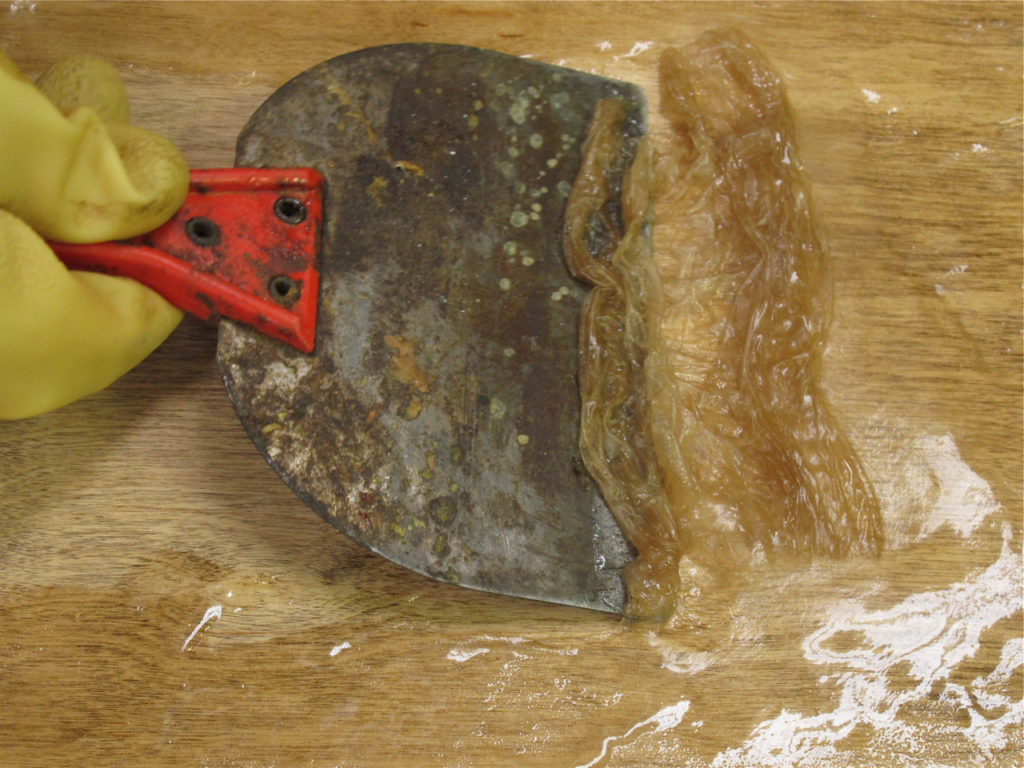We may receive a commission when you use our affiliate links. However, this does not impact our recommendations.

High-performance finishes can usually be lifted off in sheets after the stripper has had time to weaken the bond to the wood.
A professional woodworker got in touch with this question. He had finished a sixty-foot long countertop for a brewery tasting room with catalyzed (conversion) varnish. After the finish dried for three weeks, the client decided he would like the finish to be glossier and have the same amber tone as the other countertop, which had been finished with polyurethane. To complicate this woodworker’s situation even more, he couldn’t spray this newer top because the tasting room was in use and the countertop he had made was too big to move and finish somewhere else.
So his question to me was whether he could brush polyurethane over the catalyzed varnish without problems. Were the two finishes compatible?
I started the answer by saying that he had gotten himself into a bad situation. There’s really no good solution.
Polyurethane won’t cause any problems in the sense of damaging the catalyzed varnish, but it’s difficult to get anything to bond well to this finish, even more catalyzed varnish, after the window the manufacturer provides, generally around a day or less, has closed. The best chance of getting a good bond is to scuff the surface to create scratches giving the polyurethane something to grab onto. The problem with this is that catalyzed varnish dries so hard that it’s difficult to scratch.
I suggested trying with 150- or 180-grit silicon-carbide sandpaper - silicon carbide because it’s the hardest of the abrasives we have available. I also suggested trying the scuffing and the application of the poly on a small area and testing it by scraping it with a coin to see if the poly seems well bonded. I also pointed out that the polyurethane, even if it bonds well, is going to stink up the tasting room for several days. And I also suggested explaining the problem to the client.
Because … if this doesn’t work, the alternative is probably to strip the catalyzed varnish and start over.
Catalyzed varnish is, of course, not easy to strip. That’s the nature of high-performance finishes: they resist everything that could damage them. Here’s the procedure I suggested. Scuff the finish with coarse sandpaper (to increase the surface area of the finish), apply a methylene-chloride-based stripper and see if after a short time it’s possible to get a putty knife under it and lift it off in sheets. High-performance finishes don’t dissolve or blister. But sometimes their bond to the wood can be weakened enough to lift them off with a putty knife.
The best solution, however, is to see if the client can live with the differences between the two counters. He probably won’t even notice the differences anymore after a few weeks.
– Bob Flexner
Finishing Collection with Bob Flexner
Available on ShopWoodworking.com
The Finishing with Bob Flexner Collection is your comprehensive guide to everything finishing. Bob Flexner is a top authority on the subject with a lifetime of experience and a clear-cut way of explaining. With this collection, you will get three of his books, including Understanding Wood Finishing in hardcover, and both Flexner On Finishing and Wood Finishing 101 in digital format. With such a collection, you’ll never have unanswered questions on finishing again.
Here are some supplies and tools we find essential in our everyday work around the shop. We may receive a commission from sales referred by our links; however, we have carefully selected these products for their usefulness and quality.









